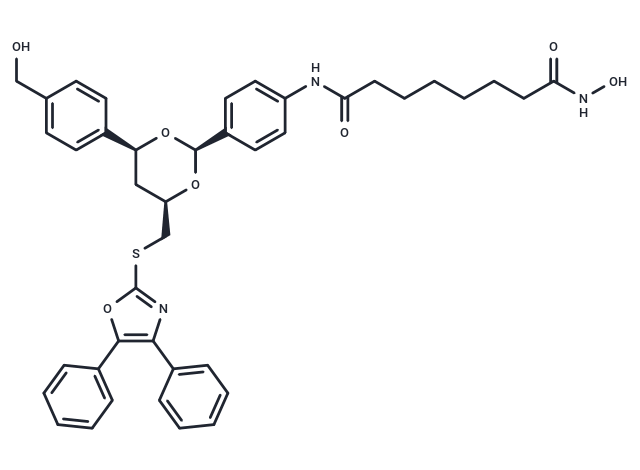Shopping Cart
- Remove All
 Your shopping cart is currently empty
Your shopping cart is currently empty

Tubacin is a highly potent and selective, reversible, cell-permeable HDAC6 inhibitor with an IC50 of 4 nM, approximately 350-fold selectivity over HDAC1.

| Pack Size | Price | Availability | Quantity |
|---|---|---|---|
| 1 mg | $77 | In Stock | |
| 5 mg | $265 | In Stock | |
| 10 mg | $496 | In Stock | |
| 25 mg | $813 | In Stock | |
| 50 mg | Preferential | In Stock | |
| 1 mL x 10 mM (in DMSO) | $418 | In Stock |
| Description | Tubacin is a highly potent and selective, reversible, cell-permeable HDAC6 inhibitor with an IC50 of 4 nM, approximately 350-fold selectivity over HDAC1. |
| Targets&IC50 | HDAC6 (cell-free assay):4nM |
| In vitro | Tubacin, without directly stabilizing microtubules, induces an increase in α-tubulin acetylation with EC50 of 2.5 μM in A549 cells. Tubacin inhibits HDAC6-mediated α-tubulin deacetylation, and inhibits the migration of both wild-type and HDAC6-overexpressing cells. Tubacin, in combination with paclitaxel, synergistically enhances tubulin acetylation. Tubacin significantly inhibits both drug-sensitive and drug–resistant MM cell growth with IC50 of 5–20 μM, and induces cell apoptosis by activation of caspases. |
| In vivo | In chick embryos, inhibition of HDAC6 activity by Tubacin reduces the formation of new blood vessels in matrigel/nylon mesh. In angioreactors implanted in mice, Tubacin also impairs the formation of new blood vessels. |
| Kinase Assay | Enzyme Inhibition Assay:Enzyme inhibition assays are performed using the Reaction Biology HDAC Spectrum platform. The HDAC1, 2, 4, 5, 6, 7, 8, 9, 10, and 11 assays used isolated recombinant human protein; HDAC3/NcoR2 complex is used for the HDAC3 assay. Substrate for HDAC1, 2, 3, 6, 10, and 11 assays is a fluorogenic peptide from p53 residues 379-382 (RHKKAc); substrate for HDAC8 is fluorogenic diacyl peptide based on residues 379-382 of p53 (RHKAcKAc). Acetyl-Lys(trifluoroacetyl)-AMC substrate is used for HDAC4, 5, 7, and 9 assays. Compounds are dissolved in DMSO and tested in 10-dose IC50 mode with 3-fold serial dilution starting at 30 μM. Control Compound Trichostatin A (TSA) is tested in a 10-dose IC50 with 3-fold serial dilution starting at 5 μM. IC50 values are extracted by curve-fitting the dose/response slopes. |
| Cell Research | Cell lines: Drug-sensitive (MM.1S,U266,INA-6,and RPMI8226) and drug-resistant (RPMI-LR5 and RPMI-Dox40) MM cell lines. Concentrations: ~20 μM. Incubation Time: 72 hours. Method:The inhibitory effect of bortezomib and/or tubacin on MM cell growth is assessed by measuring 3-(4,5-dimethylthiazol-2-yl)-2,5-diphenyl tetrazolium bromide (MTT) dye absorbance.All experiments are performed in quadruplicate. |
| Animal Research | Animal Models: Athymic nude mice implanted with angioreactorsFormulation: DMSODosages: --Administration: Tubacin is filled in semiclosed angioreactors, and then implanted into the mice. |
| Molecular Weight | 721.86 |
| Formula | C41H43N3O7S |
| Cas No. | 537049-40-4 |
| Smiles | S(C[C@@H]1O[C@@H](O[C@@H](C1)C2=CC=C(CO)C=C2)C3=CC=C(NC(CCCCCCC(NO)=O)=O)C=C3)C4=NC(=C(O4)C5=CC=CC=C5)C6=CC=CC=C6 |
| Relative Density. | no data available |
| Storage | store at low temperature | Powder: -20°C for 3 years | In solvent: -80°C for 1 year | Shipping with blue ice. | |||||||||||||||||||||||||||||||||||
| Solubility Information | DMSO: 93 mg/mL (128.83 mM), Sonication is recommended. Ethanol: <1 mg/mL H2O: <1 mg/mL | |||||||||||||||||||||||||||||||||||
Solution Preparation Table | ||||||||||||||||||||||||||||||||||||
DMSO
| ||||||||||||||||||||||||||||||||||||

Copyright © 2015-2025 TargetMol Chemicals Inc. All Rights Reserved.